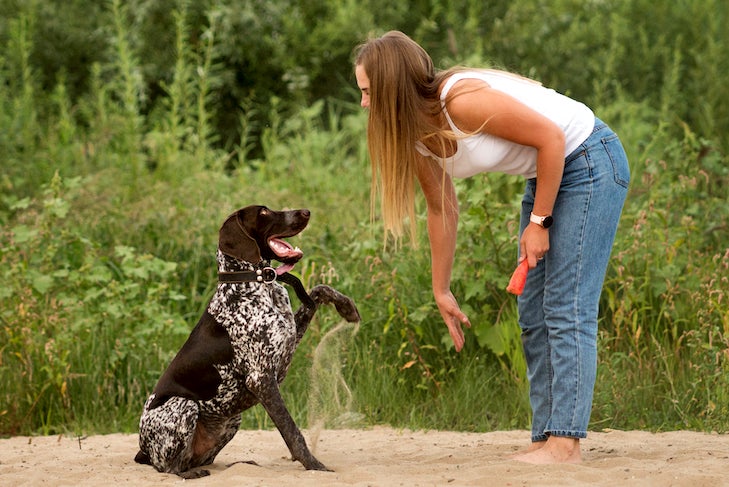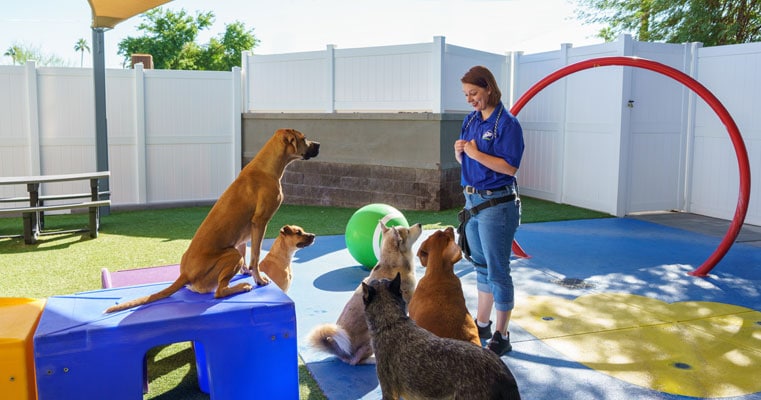The Importance of Patience and Understanding in Dog Training Practices
The Importance of Patience and Understanding in Dog Training Practices
Blog Article
Novice's Guide to Successful Canine Training at Home
Effectively educating a pet dog at home needs a nuanced understanding of canine habits and effective communication strategies. Developing clear training goals, using high-quality incentives, and keeping consistency throughout family members are important components. Incorporating training into everyday routines can improve both engagement and retention.
Comprehending Dog Behavior
Comprehending dog habits is important for reliable training and promoting a harmonious connection in between human beings and their canine friends. Pets communicate primarily with body language, vocalizations, and faces, making it important for owners to interpret these signals accurately. Recognizing behaviors such as tail wagging, growling, or cowering can provide understandings into a canine's mood and intentions.

Common behavior concerns, such as aggression, anxiety, or extreme barking, frequently originate from misunderstandings or unmet needs. Observing and attending to these issues immediately can avoid acceleration and ensure a favorable training experience. By promoting a deep understanding of canine actions, proprietors can customize their training methods to suit their canine friends, inevitably leading to a satisfied and well-behaved pet.
Important Educating Devices
A fully equipped training room can dramatically improve the effectiveness of pet dog training in your home. Vital training tools guarantee that both the fitness instructor and the canine can engage in productive sessions that foster learning and bonding.

Buying a durable chain and a comfy, well-fitting collar or harness is essential for safety and control. These tools help develop boundaries and guarantee the canine continues to be protected throughout training. Furthermore, a marked training location, devoid of distractions, aids focus for both the dog and the fitness instructor.
Educating aids such as training pads, cones, or agility equipment can also boost the experience by introducing range and difficulties. Last but not least, having a note pad or digital app for tracking development can be important, permitting you to note successes and locations for enhancement. Utilizing these essential devices will produce a favorable training setting and lay the structure for reliable understanding.
Developing an Educating Routine
Establishing a constant training regimen is essential for efficient pet dog training at home. A well-structured regular not just assists in enhancing wanted habits but also supplies your pet dog with a complacency and predictability. To develop an effective training regular, start by recognizing specific training goals, such as fundamental commands, chain strolling, or housebreaking.
Pick a designated time daily for training sessions, preferably when your pet is alert and receptive. Procedure must be brief, approximately 5 to 15 mins, to keep focus and protect against tiredness. Consistency in timing and environment will boost your dog's understanding experience.
Include training right into day-to-day activities to reinforce abilities. As an example, practice commands throughout strolls or nourishment, which incorporates learning right into all-natural regimens. In addition, continue to be flexible and readjust the regular as visit this site necessary, suiting your pet's energy degrees and mood.
Favorable Support Strategies
Favorable reinforcement methods are essential to reliable pet training, promoting wanted actions with rewards instead than punishment. This technique uses favorable stimuli, such as deals with, praise, or playtime, to encourage dogs to repeat details activities. The cornerstone of this strategy is timing; rewards need to be offered right away following the desired actions to develop a clear organization.
When executing positive support, it is important to pick incentives that are encouraging for your pet dog. High-value treats, such as little items of chicken or cheese, can be specifically effective throughout training sessions. In addition, differing the rewards can preserve your canine's passion and excitement.
Beginning with basic commands, like "rest" or "stay," and slowly progress to a lot more intricate tasks. Uniformity is vital; make sure that all household members make use of the very same commands and benefit systems to stay clear of complication.
Moreover, it is vital to remain person and avoid aggravation. Canines, like human beings, discover at their very own pace. By cultivating an encouraging training environment via positive reinforcement, you can enhance your pet's discovering experience while enhancing the bond in between you and your hairy buddy, preparing for effective training results.
Usual Educating Obstacles
While educating a pet dog in the house can be a fulfilling experience, it typically features a set of common challenges that can test both perseverance and uniformity. One prevalent problem is diversion. Pet dogs might come to be easily sidetracked by sounds, movements, or perhaps aromas in their environment, making it difficult to preserve find this their focus during training sessions.
Another obstacle is variance in commands and reinforcement. If household participants utilize various signs or benefits, it can perplex the canine and hinder development. Developing a unified technique is essential for reliable communication.
In addition, pet dogs can experience irritation or stress, especially if they do not understand what is anticipated of them. This can bring about unwanted actions, such as chewing or barking.
Lastly, the timing of reinforcement is critical (Dog training). Delayed benefits can diminish the effectiveness of positive support, as pet dogs may stop working to link the actions with the reward
Getting rid of these obstacles needs dedication, clear interaction, and a structured training strategy. Acknowledging and dealing with these common barriers will lead the way for a much more delightful and effective training experience at home.
Verdict
In conclusion, effective pet training in your home demands a detailed understanding of canine habits and efficient interaction techniques. By developing clear training goals and making use of top quality deals with along with positive reinforcement, the training process comes to be extra gratifying for both the pet dog and the trainer. Versatility, perseverance, and uniformity are crucial components that facilitate learning. Ultimately, integrating training into daily routines enhances the bond between pet and owner, making the experience both delightful and productive.
Establishing a constant training regimen is crucial for reliable dog training at home.Favorable support strategies are this post essential to effective canine training, promoting wanted behaviors with benefits instead than penalty (Dog training). By cultivating a helpful training setting through positive reinforcement, you can enhance your pet's learning experience while reinforcing the bond between you and your hairy friend, laying the groundwork for successful training end results
In verdict, successful canine training at home requires a comprehensive understanding of canine behavior and effective interaction methods. By developing clear training objectives and utilizing high-grade treats together with positive reinforcement, the training process comes to be more rewarding for both the canine and the instructor.
Report this page